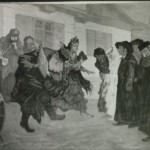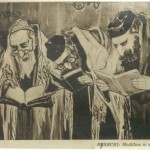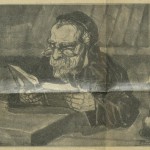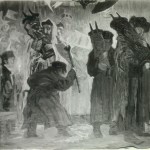My search for my great-grandfather’s lost paintings is neither hopeless nor quixotic: I have found dozens of lost works, and have evidence that at least several dozen, and possibly hundreds, remain to be found. But it’s just not possible to find more of the lost art on any sort of timetable. Instead, there is a lot of waiting for something to happen. In between discoveries in my own search I sometimes am connected to other people’s wonderful quests. This post is about one of those stories.
As many readers know, in October 2013 I made the remarkable discovery of the Otto Schneid archive at the Thomas Fisher Rare Book Library at the University of Toronto. The archive has letters written by my great-grandfather and photographs of several of his paintings (the four presented here are from the archive). As a result of my learning about the Otto Schneid archive, I also connected to one of Schneid’s sons, Adam, and his wife, Chaia. In June I visited them in Canada and we had a lovely visit where we marveled at our finding one another and the history that links our two families. I think I kept saying, “imagine if Otto and Moshe could see us sitting here together in a restaurant…” and we all just shook our heads, all a bit shell shocked at our having found one another.
My connection with Adam and Chaia has now led me to another fabulous story. This one is not a Moshe Rynecki story, but it is a lovely and delightful one from Chaia’s cousin, Lil Blume, and her search for her grandmother’s lost story. All of Lil’s life she had heard her grandmother wrote articles and stories for Yiddish publications, but she’d never seen or read any. Eventually she went searching for one and discovered a tale of her great-grandfather’s antiquarian Jewish bookstore in Warsaw in the 1890s. The story is a historically important and charming glimpse into a lost world.
I very much enjoyed the story Lil’s grandmother wrote, but it is the stories behind the story that I particularly love about Lil’s tale. In her piece, Writing in the Family, Lil shares the path of her search and the people along the way who helped her. My favorite line in the piece is, “I sent an email to the library telling them about my search and received a response ten minutes later as if they had been waiting to hear from me.” This line gave me the chills. I’ve had very similar experiences and it always makes me wonder what else is out there that we just don’t know how to access.
As if Lil’s find of the story wasn’t enough, she has another marvelous story-behind-the-story which she shared with me in an email:
The story of finding my grandmother’s writing was published in an anthology called Living Legacies: A Collection of Writing by Contemporary Canadian Jewish Women, Volume II, ed. Liz Pearl, PK Press, 2010. I read my story at the launch and when I was done, a woman in the audience said “I knew your grandmother.”
I thought she was mistaken and that she must mean my mother, who is still active at 87.
“No,” the woman said, “I knew your grandmother. We used to visit your grandmother all the time when I was a child. This woman then named my aunt and uncles.
It turns out the woman was the daughter of the Canadian Yiddish poet YY Segal. Segal had been a great friend of my grandmother and took his young daughter with him when he visited. I talked with her after to see what I could learn about my family. She spoke of how poor my grandmother’s family were. She said, “The Halperns were poor. Everyone was poor. But the Halperns were more poor.”
I love stories like these. It is, as Lil wrote to me, “fascinating and grounding finding the creative works of our ancestors.” Indeed. Our searches continue.



